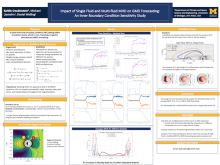Impact of Single Fluid and Multifluid MHD on GMD Forecasting: An Inner Boundary Condition Sensitivity Study
Kaitlin
Doublestein
Department of Climate and Space Science and Engineering, University of Michigan
Poster
Altering global MHD model inner boundary conditions, such as temperature, parallel velocity, and ion composition can impact ground magnetic disturbances (GMD) by changing the geospace response to solar drivers. As solar and magnetospheric activity increases, we see an increase in light and heavy ion densities in Earth’s magnetosphere. These additional ions impact physical processes, including reconnection rates, ring current development, and wave environments. Many of the physical mechanisms responsible for additional ion outflow are not included in the idealized magnetohydrodynamic (MHD) equations. The Space Weather Modeling Framework (SWMF) using a passive static inner boundary condition [e.g., Welling & Liemohn, 2014] approximates outflow magnitude with ideal MHD equations, but does not accurately show the outflow pattern. To better reflect the ion composition this requires us to switch from ideal MHD equations to a multifluid MHD equation set, allowing for multiple ion species to be present, solving for separate momentum and energy equations. Changing between these two equation types results in higher computational costs and diverges from real-time analysis, but may improve simulated ground-based magnetometer results by reflecting an accurate ion outflow pattern. We compare the ground magnetic response as a function of ion outflow type, exploring the importance of mass outflow on GMD. Both single and multifluid MHD equation sets are exercised. The overall effect of inner boundary conditions on GMD forecasting is summarized.

Poster PDF
Poster category
Geospace/Magnetosphere Research and Applications
Meeting homepage